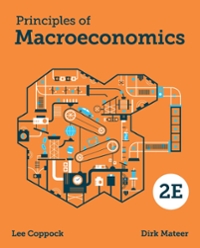help solve this, its macro
1. In a two-consumer (Ms. A and Mr. B), two-commodity, X, and X2, pure ex- change economy, A's preferences are represented by the utility function: Consumer B's preferences are represented by the following utility func- tion: UB(15, 17) = Q15 +15 where ; denotes the quantity of commodity j E {1, 2} consumed by consumer i E { A, B}. Assume, first, that the parameter a is such that a = (1) The total quantities available in the economy of commodity z1, denoted by i1, and of commodity x2, denoted by 12, are identical. Further, assume that the endowment allocation is such that A owns half of the entire quan- tity available of commodity 1, 71/2, and half of the quantity available of commodity 2, 12/2. (i) Find the offer curves of both Ms. A and Mr. B. (ii) Find the set of Walrasian equilibrium prices and allocations in this economy. (iii) Are the Walrasian equilibrium allocation(s) you find in (ii) above Pareto efficient? Explain your answer. 2. Now consider the following modification of the economy in 1 above. Assume that A's preferences are unchanged while B's preferences are character- ized by the following value of the parameter a 0 = 4 (2) (iv) Find the new offer curve of Mr. B. (v) Find the set of Walrasian equilibrium prices and allocations in this modified economy. (vi) Are the Walrasian equilibrium allocation(s) you find in (v) above Pareto efficient? Explain your answer. 3. Finally, consider the following third modification of the economy in 1 above. Assume that A's preferences are unchanged while B's preferences are characterized by the following value of the parameter a a = 4/3 (3) (vii) Find the new offer curve of Mr. B. (viii) Find the set of Walrasian equilibrium prices and allocations in this modified economy. (ix) Are the Walrasian equilibrium allocation(s) you find in (v) above Pareto efficient? Explain your answer.4. In a two-consumer (Ms. A and Mr. B), two-commodity, 1 and 2, pure ex- change economy, A only likes commodity 1 and she does not care how many units of commodity 2 she consumes. In other words, A's utility function is: Consumer B's preferences are represented by the following utility func- tion: 2 where r denotes the quantity of commodity j e {1, 2} consumed by consumer i E { A, B}. Assume that the total quantities available in the economy of commodity 1, denoted by 1, and of commodity :2, denoted by 12, are such that: $1 = Assume first that that A owns the entire quantity available of commodity 1, I1, while B owns the entire quantity available of commodity 2, 12. (i) Does a Walrasian equilibrium exist in this economy? ii) If so, what is the Walrasian equilibrium price and allocation? (iii) Find the Pareto-efficient allocation(s) in this economy. (iv) Is the Walrasian equilibrium allocation Pareto efficient? Explain your answer. 5. Now consider the following modification of the economy in 4 above. Assume that A owns half of the available quantity of commodity 1, (1/2) 71, and the entire available quantity of commodity 2, 12, while B owns the other half of the available quantity of commodity 1, (1/2) 71. (v) Does a Walrasian equilibrium exist in this modified economy? (vi) If so, what is the Walrasian equilibrium price and allocation? (vii) Find the Pareto-efficient allocation(s). (vili) Is the Walrasian equilibrium allocation Pareto efficient? Explain your answer.1. Consider a technology that produces a single output y using two inputs 1 and 12. Assume that the techology has the following characteristics. Each unit of output y can be produced either by means of 3 units of input 1 and a quantity of input z2 such that 0 CI and F(1}= t]. In this modern era. each student maximizes his utility with respect to the variable under his own control, 3:, for a given level of 3;. [ii] What are the equilibrium values of z. y and utility? Smpose now that all students get toge'mer and hire a consultant to plan for the socially optimal level of work. {iii} What is the socially optimal value of z. and how does this differ from the decentralized case above? {iv} why is it difficult for the students to reach this solution by individual choice of hours of work. without collusion or coercion? M If hours of won; were publicly measurable. how could the socially opti- mal solution be aohleved by quote. or a taxrsubsidy scheme










